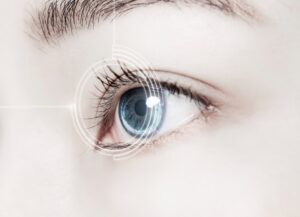Myopia, or nearsightedness, impacts distance vision. It often stems from irregularities in the eye’s structure, such as an elongated eye shape or an overly curved cornea. Its onset usually occurs during childhood and can progress as the eyes continue to grow. Factors such as genetics, extended near work, and limited outdoor activities also contribute to its development.
Orthokeratology, or OrthoK therapy, is a non-surgical treatment for correcting nearsightedness.
 Orthokeratology lenses are rigid, gas-permeable moulds that work their wonders overnight. Users remove the lenses upon waking, immediately experiencing clearer and sharper vision without needing glasses or daytime contact lenses.
Orthokeratology lenses are rigid, gas-permeable moulds that work their wonders overnight. Users remove the lenses upon waking, immediately experiencing clearer and sharper vision without needing glasses or daytime contact lenses.
The lenses are specially crafted for each patient and gently reshape the cornea during sleep. To create the correct contact lens for each individual, the surface curvature of the cornea is mapped using a topography machine. This information, as well as the patient’s refraction is then used to design the customised lens.
However, the improved eyesight is not permanent. Myopia begins its slow return after approximately 12 hours. Over time, the duration of clear vision can extend; some people may experience perfect vision for up to two days. And, it’s not for everybody. Let’s look at the advantages and disadvantages of Orthokeratology.
Advantages of Orthokeratology for myopia control
Non-invasive treatment
One of the standout advantages of Ortho-K is its non-invasive nature. These lenses are worn overnight, reshaping the cornea during sleep. This appeals to individuals wary of surgical interventions, providing a gentler alternative for myopia control.
Daytime freedom
Ortho-K offers users the freedom of clear daytime vision without the reliance on glasses or daytime contact lenses. This advantage is particularly significant for those with active lifestyles, allowing seamless participation in sports and outdoor activities.
Slows Myopia progression
Scientific studies suggest that Ortho-K may play a pivotal role in slowing the progression of myopia, especially in children and adolescents. As unchecked myopia in early years can lead to higher myopia in adulthood and is associated with an increased risk of eye diseases, this is definite plus.
Peripheral vision improvement
By addressing the central corneal curvature, Ortho-K lenses have the potential to enhance peripheral vision. This is of special benefit for tasks such as driving and sports, where a broad field of clear vision is essential.
Disadvantages of Orthokeratology for myopia control
Adaptation period
Initially, some users may experience discomfort or temporary visual disturbances. However, that these issues often lessen with continued use as the eyes adjust to the lenses.
Maintenance
Proper lens care is crucial with Ortho-K lenses. As with all forms of contact lenses, there is a slight risk of infection. This is extremely rare and that is why we give careful cleaning instructions and advise regular follow-ups with our optometrists to monitor eye health and ensure the lenses are fitting correctly.
Not Universally suitable
Ortho-K lenses may not be suitable for everyone, particularly people with certain eye conditions or irregular corneas. A thorough eye examination is necessary to determine eligibility and suitability.
Cost considerations
While Ortho-K lenses present long-term benefits, the initial investment and ongoing maintenance costs may be higher when compared to traditional contact lenses or eyeglasses. However, when it comes to effective myopia control and the long-term benefits, many users find the advantages outweigh the costs.
Tired of wearing glasses or contacts or want a more convenient and effective way to correct your vision?
Ortho-k lenses may be the solution. Orthokeratology can be a good choice for dealing with nearsightedness, but not everyone is suited. Knowing how nearsightedness can be different for people of different ages and stages shows why it’s so important to be clear on the advantages and disadvantages of Orthokeratology. The optometrists at John O’Connor are really skilled at working with nearsightedness and can suggest solutions that fit each person.
Are you a candidate for Orthokeratology?
The best way to determine if you are a good candidate would be to book in for a full eye examination with us. Our optometrist will carefully assess your eye health, corneal shape, lifestyle and visual requirements to ensure that the treatment is right for you.
Interested in better vision?
Send us an email here, to find out more or give us a call to book in for a free chat with one of our optometrists about the advantages and disadvantages of Orthokeratology and whether it’s right for you. You can reach our Newmarket Optometrists at 09 522 1283 or our Henderson Optometrists at 09 836 1731. Alternatively, you can send us an email via our contact page.

